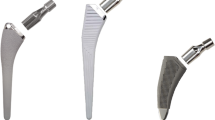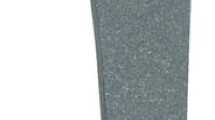Abstract
Background
While modular femoral heads have been used in THA for decades, a recent innovation is a second neck-stem taper junction. Clinical advantages include intraoperative adjustment of leg length, femoral anteversion, and easier revision, all providing flexibility to the surgeon; however, there have been reports of catastrophic fracture, cold welding, and corrosion and fretting of the modular junction.
Questions/purposes
We asked whether (1) the neck-stem junction showed the same degradation mechanisms, if any, as the head-neck junction, (2) the junction contributed to THA revision, (3) the alloy affected the degree of degradation, and (4) the trunion machine finish affected the degradation mechanisms.
Methods
We compared 57 retrievals from seven total hip modular designs, three cobalt-chromium-molybdenum and four titanium based: Bionik® (four), GMRS® (four), Margron® (22), Apex® (five), M-series® (five), ZMR® (two), and S-ROM® (15). Macroscopic inspection, microscopy, and micro-CT were conducted to determine the effects of materials and design.
Results
The cobalt-chromium-molybdenum components showed crevice corrosion and fretting of the neck-stem taper, whereas the titanium components had less corrosion; however, there were several cases of cold welding where disassembly could not be achieved in theater.
Conclusions
Even with modern taper designs and corrosion-resistant materials, corrosion, fretting, and particulate debris were observed to a greater extent in the second neck-stem junction. Titanium-based modular arthroplasty may lessen the degree of degradation, but cold welding of the components may occur.
Clinical Relevance
Degradation of the second junction contributed to 8 cases of metallosis and two cases of aseptic lymphocyte-laminated vascular-associated lesions contributing to revision.




Similar content being viewed by others
References
Atwood SA, Patten EW, Bozic KJ, Pruitt LA, Ries MD. Corrosion-induced fracture of a double-modular hip prosthesis: a case report. J Bone Joint Surg Am. 2010;92:1522–1525.
Australian Orthopaedic Association. AOA National Joint Replacement Registry. Annual Report 2010. Available at: http://www.dmac.adelaide.edu.au/aoanjrr/documents/aoanjrrreport_2010.pdf. Accessed May 10, 2011.
Berry DJ, Von Knoch M, Schleck CD, Harmsen WS. The cumulative long-term risk of dislocation after primary total hip arthroplasty, J Bone Joint Surg Am. 2004;86:9–14.
Cameron HU. The proximal modular neck in THA: a bridge too far: opposes. Orthopedics. 2010;33:641.
Collier JP, Mayor MB, Williams IR, Surprenant VA, Surprenant HP, Currier BH. The tradeoffs associated with modular hip prostheses. Clin Orthop Relat Res. 1995;311:91–101.
Cook SD, Barrack R, Clemow AJ. Corrosion and wear at the modular interface of uncemented femoral stems. J Bone Joint Surg Br. 1994;76:68–72.
Dunbar MJ. The proximal modular neck in THA: a bridge too far: affirms. Orthopedics. 2010;33:640.
Fraitzl C, Buly R, Castellani L, Moya L. Corrosion at the sleeve-stem interface of a modular titanium alloy femoral component. J Bone Joint Surg Br. 2010;92(Suppl IV):514–515.
Fricker DC, Shivanath R. Fretting corrosion studies of universal femoral head prostheses and cone taper spigots. Biomaterials. 1990;11:495–500.
Frost RB, Sekel R, Kandel L. The engineering design of the MARGRON® femoral hip prosthesis system. J Eng Design. 2003;14:115–127.
Garbuz DS, Tanzer M, Greidanus NV, Masri BA, Duncan CO. The John Charnley Award. Metal-on-metal resurfacing versus large diameter head metal-on-metal total hip arthroplasty: a randomized clinical trial. Clin Orthop Relat Res. 2010;468:318–325.
Goldberg JR, Gilbert JL, Jacobs JJ, Bauer TW, Paprosky W, Leurgans SA. Multicenter retrieval study of the taper interfaces of modular hip prosthesis. Clin Orthop Relat Res. 2002;401:149–161.
Jacobs JJ, Skipor AK, Patterson LM, Hallab NH, Paprosky WG, Black J, Galante JO. Metal release in patients who have had a primary total hip arthroplasty: a prospective, controlled, longitudinal study. J Bone Joint Surg Am. 1998;80:1447–1458.
Jacobs JJ, Urban RM, Gilbert JL, Skipor AK, Black J, Jasty M, Galante JO. Local and distant products from modularity. Clin Orthop Relat Res. 1995;319:94–105.
Khan MA, Williams RL, Williams DF. In-vitro corrosion and wear of titanium alloys in the biological environment. Biomaterials. 1996;17:2117–2126.
Kop AM, Swarts E. Corrosion of a hip stem with a modular neck taper junction: a retrieval study of 16 cases. J Arthroplasty. 2009;24:1019–1023.
Kretzer JP, Jakubowitz E, Krachler M, Thomsen M, Heisel C. Metal release and corrosion effects of modular neck total hip arthroplasty. Int Orthop. 2009;33:1531–1536.
McTighe T. Cementless modular stems. 2002. Joint Implant Surgery and Research Foundation. Available at: http://www.jisrf.org/pdf files/Updated0402.pdf. Accessed May 10, 2011.
Pallini F, Cristofolini L, Traina F, Toni A. Modular hip stems: determination of disassembly force of a neck-stern coupling. Artif Organs. 2007;31:166–170.
Patntirapong S, Habibovic P, Hauschka PV. Effects of soluble cobalt and cobalt incorporated into calcium phosphate layers on osteoclast differentiation and activation. Biomaterials. 2009;30:548–555.
Salvati EA, Lieberman JR, Huk OL, Evans BG. Complications of femoral and acetabular modularity. Clin Orthop Relat Res. 1995;319:85–93.
Schramm M, Wirtz DC, Holzwarth U, Pitto RP. The Morse taper junction in modular revision hip replacement—a biomechanical and retrieval analysis. Biomed Tech (Berl). 2000;45:105–109.
Sporer SM, Della Valle C, Jacobs J, Wimmer M. A case of disassociation of a modular femoral neck trunion in total hip arthroplasty. J Arthroplasty. 2006;21:918–921.
US Food and Drug Administration. MAUDE database. 2009. Available at: www.accessdata.fda.gov/scripts/cdrh/cfdocs/cfMAUDE/search.cfm. Accessed May 10, 2011.
Viceconti M, Baleani M, Squarzoni S, Toni A. Fretting wear in a modular neck hip prosthesis. J Biomed Mater Res. 1997;35:207–216.
Viceconti M, Ruggeri O, Toni A, Giunti A. Design-related fretting in modular neck hip prosthesis. J Biomed Mater Res. 1996;30:181–186.
Willert HG, Buchhorn GH, Fayyazi A, Flury R, Windler M, Köster G, Lohmann CH. Metal-on-metal hypersensitivity in patients with artificial hip joints: a clinical and histomorphological study. J Bone Joint Surg Am. 2005;87:28–36.
Acknowledgments
The authors thank all orthopaedic surgeons in Western Australia who continue to support the Royal Perth Hospital Retrieval Service and consistently send retrievals for analysis. We also acknowledge assistance from Dr David Morrison and Dr Andrew Campbell with regard to the micro-CT image manipulation.
Author information
Authors and Affiliations
Corresponding author
Additional information
Each author certifies that he or she, or a member of their immediate family, has no commercial associations (eg, consultancies, stock ownership, equity interest, patent/licensing arrangements, etc) that might pose a conflict of interest in connection with the submitted article.
All ICMJE Conflict of Interest Forms for authors and Clinical Orthopaedics and Related Research editors and board members are on file with the publication and can be viewed on request.
Clinical Orthopaedics and Related Research neither advocates nor endorses the use of any treatment, drug, or device. Readers are encouraged to always seek additional information, including FDA approval status, of any drug or device before clinical use.
Each author certifies that his or her institution approved the investigation and that all investigations were conducted in conformity with ethical principles of research.
Electronic supplementary material
Below is the link to the electronic supplementary material.
About this article
Cite this article
Kop, A.M., Keogh, C. & Swarts, E. Proximal Component Modularity in THA—At What Cost?: An Implant Retrieval Study. Clin Orthop Relat Res 470, 1885–1894 (2012). https://doi.org/10.1007/s11999-011-2155-9
Published:
Issue Date:
DOI: https://doi.org/10.1007/s11999-011-2155-9




